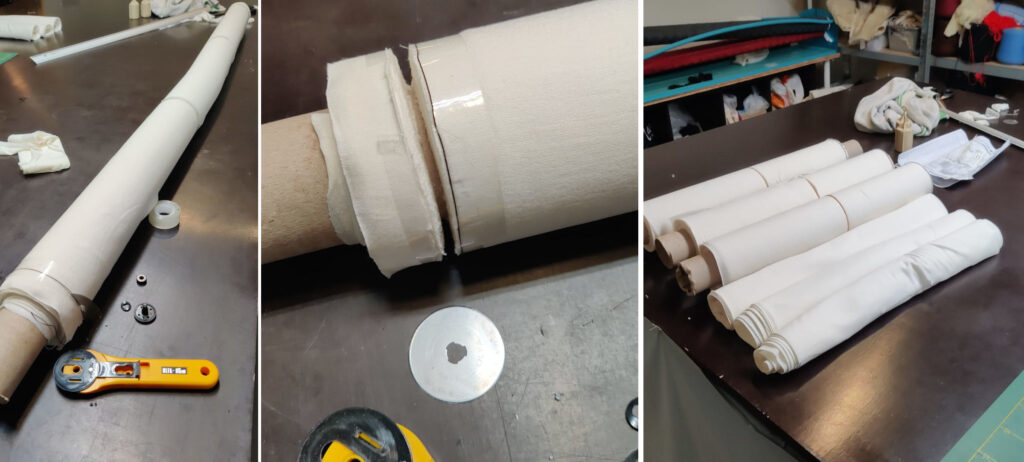The first week has been completed, and it’s time for some comments and take-away!
This article will probably be of little use to those who have already experience in textile manufacturing, but I suspect very helpful to everyone else, especially to those of you who would like to start your own hub from scratch.
First of all, I am extremely happy. The crew is sweet, this week we took our time to think, to know each other and to create our shared working place. It’s only the first week, but I am reassured that the pilot was a very good first step for this project: it’s providing a lot of food for thought and insight on the organizational little things. Personally, I am learning a lot.
Our planned program for the first two sessions was:
June 10th
+ getting ready & discussing the news (moved to the 11th because we rushed to step 2!);
+ opening the material;
+ checking the patterns for the neckgaiters;
= thinking about production methods and who does what;
= cutting the material for the neckgaiters.
June 11th
– finishing to cut?
+ Starting production neckgaiter;
– test neckgaiter production at full speed (last hour).
+ is completed
= is ongoing
– is failed
We have accomplished almost everything, except two things: the material is not all cut to size, and we were not able to try full production at speed. This is somehow to expect, since it’s the first time we ever do anything together. In addition, we started with jersey, which is a very difficult fabric to work with, and this jersey in particular is sooooo fine and soft, and the thread is quite small. It’s beautiful, it feels amazing on the skin, but it is difficult to spot the true from the wrong side (even to professionals!), it moves and stretches a lot and it is very difficult to cut at very precise sizes.
Our first test was to produce an item we had never produced before. From what happened, I would recommend to have in the room someone who already produced a prototype of the item you want to produce. Obviously, instructions help, but if you’re familiar with the exact instruction challenge exercise ;), you will know that no matter how exact and precise the instructions are, there is still room for error, especially if we count on engaging with people who, like myself, have little experience in sewing professionally.
This should be systematic in each hub: the crews start producing only after one of them has gone through the exercise of building the whole item, and can demonstrate to everyone else. Otherwise, crews will likely try to solve problems all at the same time, which is very inefficient and it may become frustrating.
A second recommendation is to have a special room for problem solving, and have a solving crew. This is a principle taken straight from management in complexity ad crisis management: in times of crisis we need to be ready to reassembling ourselves in crews with clear roles. So from now on we will have a solving crew of two, and a special room with a machine ready for them, while the other can happily continue producing without stress. When the problem is solved, we celebrate with a nice demo and kudos to the solvers.
Last but not least, cutting!
We are not in a big production facility with automatic or even simply big manual machines, and to be honest it’s not in our intention to transform our workspace into a factory. So it is obvious that cutting could be a big bottleneck, always, and a source of creative thinking.
Luckily in Green Fabric there are a lot of tools, and there’s even an electric cutter, which you can see in the main photo. But with this material it was really hard to prepare thick stacks without wrinkles or some deformations. So since we’re producing an item that in its open form is a pure rectangle, I thought to cut the fabric directly on the roll.

Here’s the process in photos: first, disassemble the roller cutter, then use the blade to cut three slices, slide the slices so there is a bit of cardboard between them, and finally cut the cardboard core. In the last picture of this series you see the three final rolls still in their cardboard tubes, and three rolls that we cut with by unfolding the material and laying it out on the table first, to re-roll it once cut.
To compare: it took 10 mins to cut 30mt of material on the roll vs 30 mins to cut 5mt with the other method.
I’m sure there are many other ways to do this, and I’m very interested in learning more. If you have done this before, just let me know.
However, it’s clear that depending on the item we will need a custom solution, however with other kinds of fabric it should all be much simpler.
Now we’re getting ready for next week, where we finally test production at speed. Our goal is to make 5 items per hour, per person, so 20 items per hour. Will we make it? Will we overdeliver? Will we fail? I am very excited to find out. Stay tuned for more news!


Leave a Reply